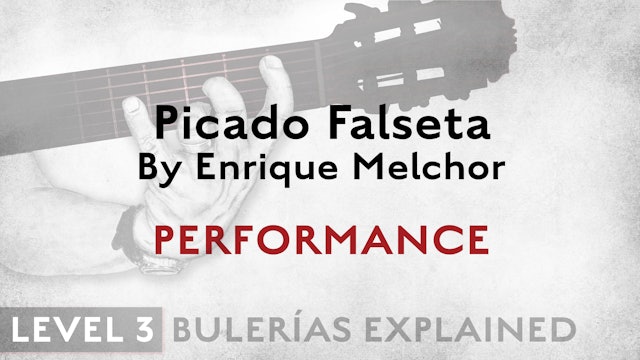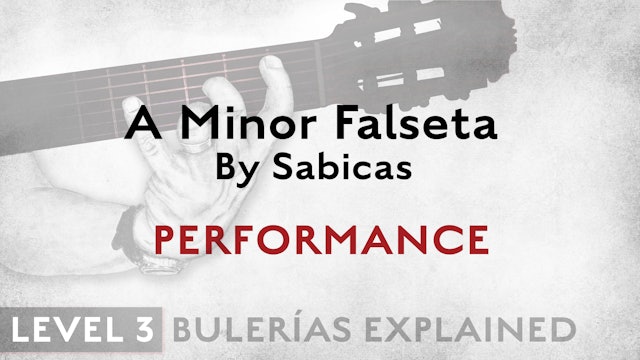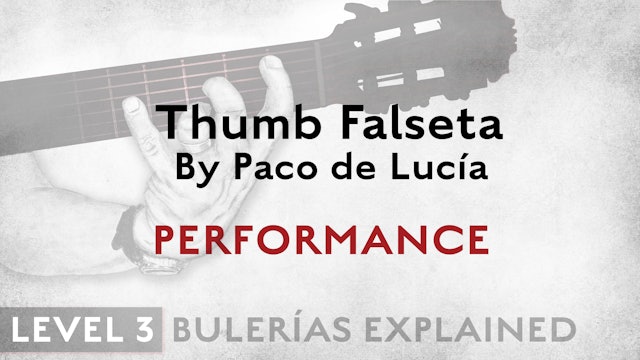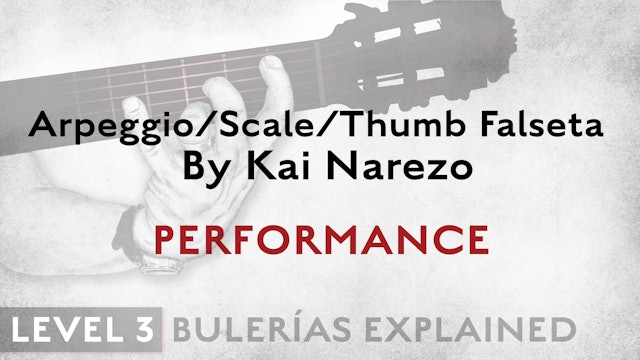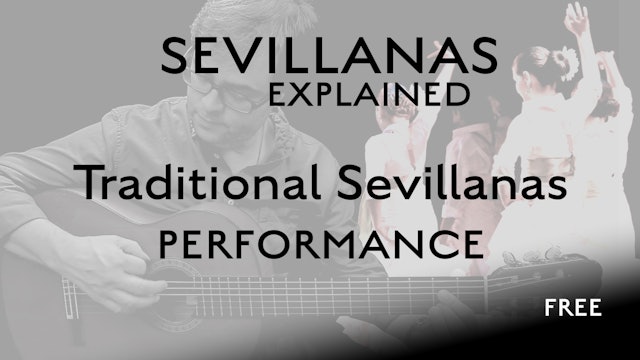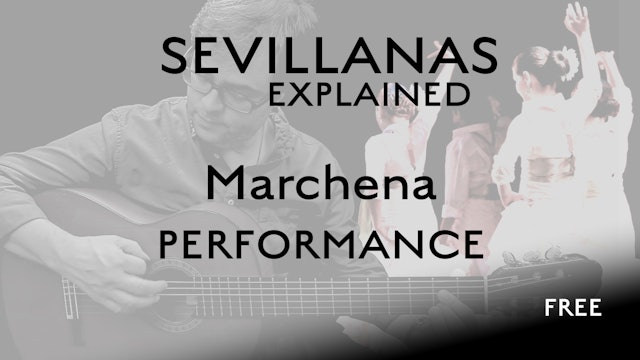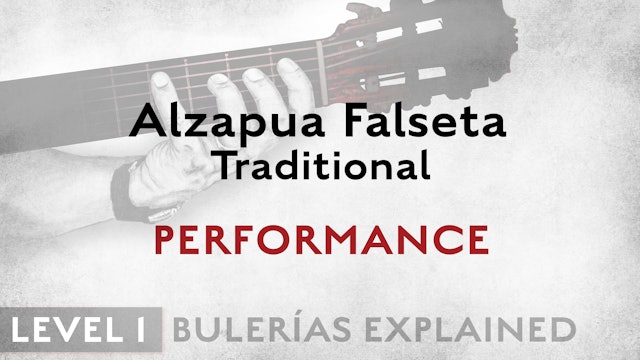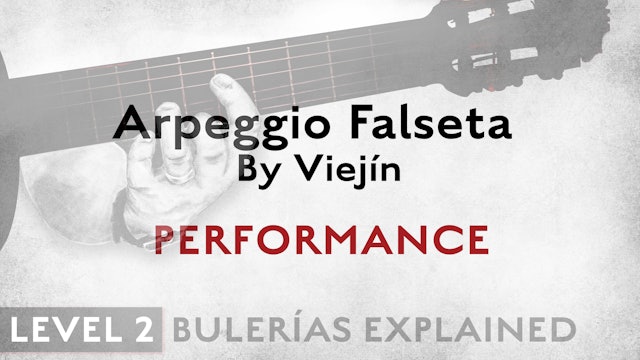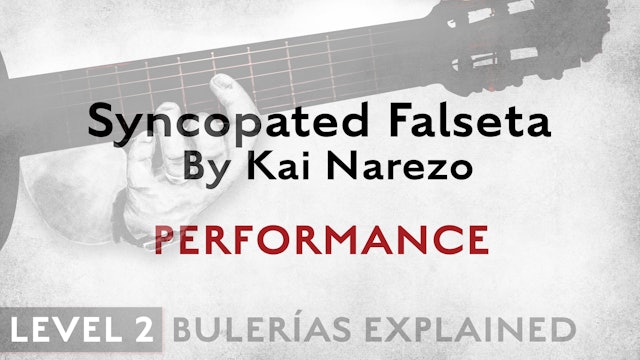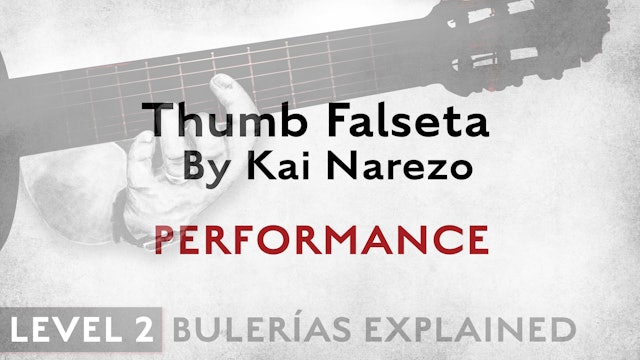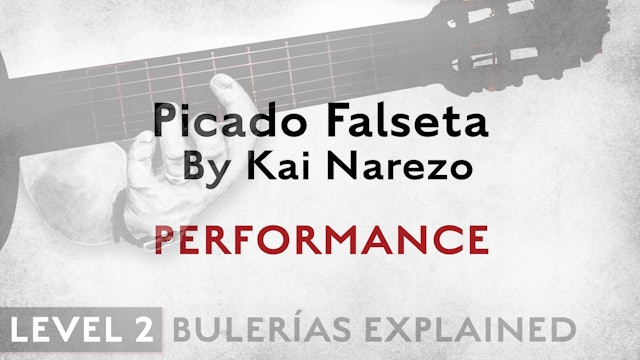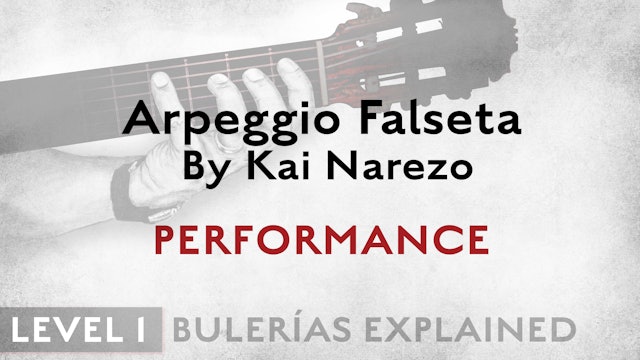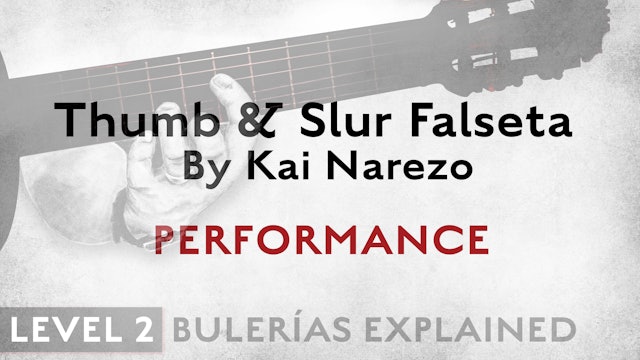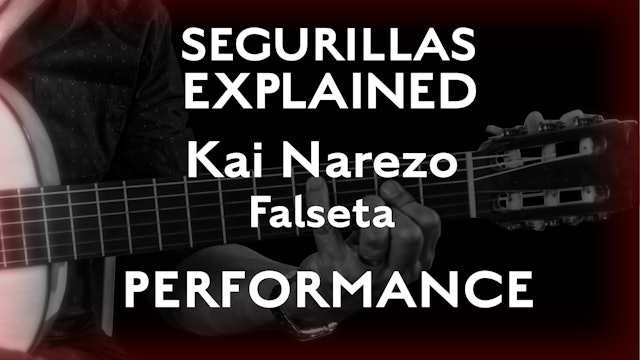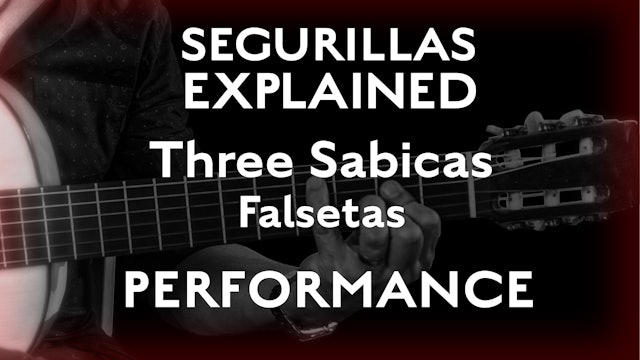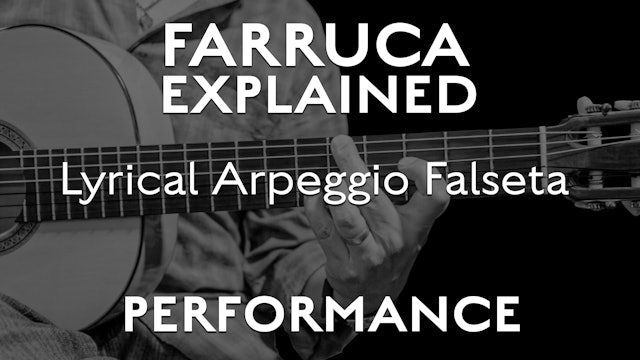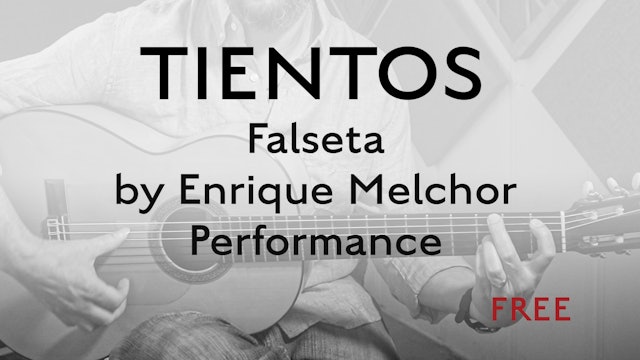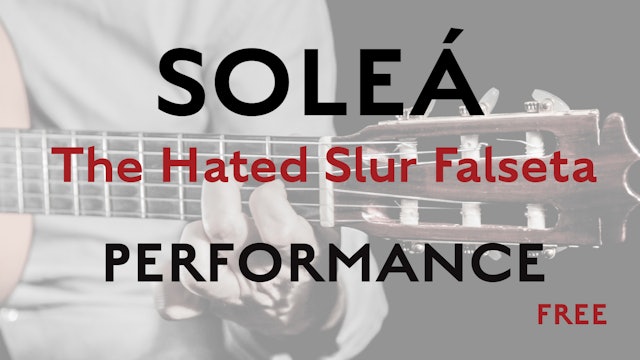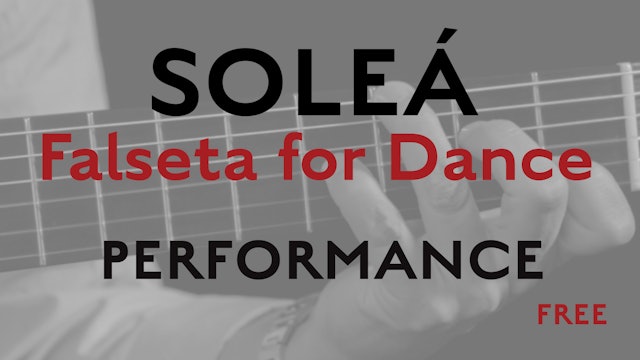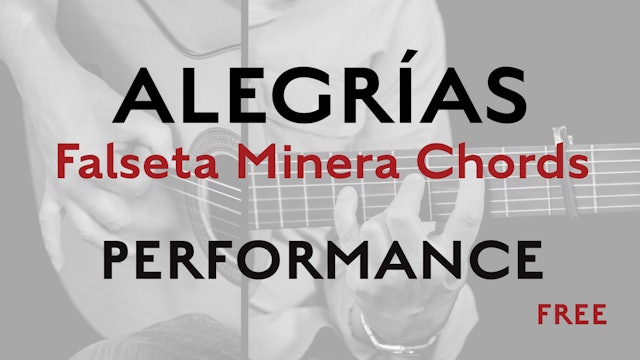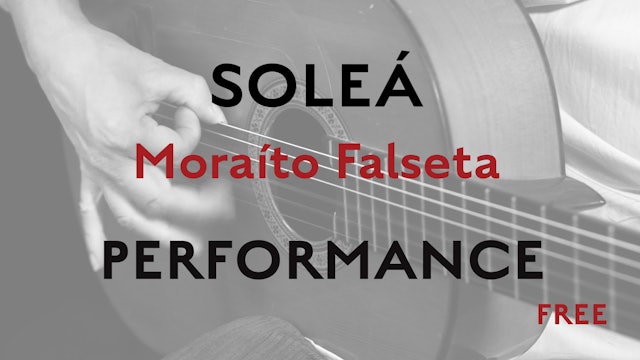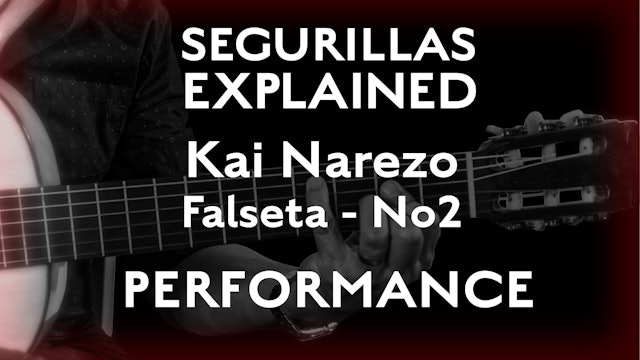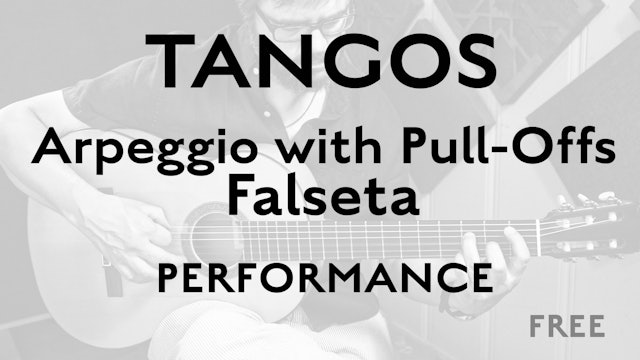-
Bulerias Explained - Level 3 - Picado Falseta by Enrique Melchor - PERFORMANCE
This picado falseta by Enrique Melchor features both the symmetric diminished scale, which is a staple of modern flamenco, and diminished arpeggios, which are somewhat more traditional. You may find you disagree with the fingerings given, which is fine if you find an easier way for you to play th...
-
Bulerias Explained - Level 3 - A Minor Falseta by Sabicas - PERFORMANCE
Sabicas was famous for his minor Bulerías, and this may be his most famous falseta of all. It’s almost all picado in eight notes, and the phrases start on beat 1 and 7 instead of the more common beats 12 and 6.
-
Bulerias Explained - Level 3 - Thumb Falseta by Paco de Lucia - PERFORMANCE
We had to include at least on Paco de Lucia falseta in the course, and this one seems to have been one of Paco’s favorites, given how often he played it. There’s a lot going on, both rhythmically and technically, so take this one slow and make sure you understand where each phrase starts and stop...
-
Bulerias Explained - Level 3 - ArpegScaleThumb Falseta by Kai Narezo - PERFORM
This Bulerías falseta starts out with a Major 7 sound (the Vicente Amigo influence) that combines arpeggio and picado, but it ends with a driving thumb figure that changes the energy of the falseta - and that can also be used on its own.
-
Traditional Sevillanas - Performance
These Sevillanas for solo guitar are great for learning Sevillanas, working on your technique and accompanying dance, too. Learn one at a time, and each one will be easier than the previous one as you get the hang of the structure.
-
Marchena (Sevillanas) - Performance
Four Sevillanas in four different keys (E, A, F# and B phrygian). These Sevillanas are pretty advanced both technically and rhythmically, so you may want to review the Traditional Sevillanas tutorial before tackling this.
-
Bulerias Explained - Level 1 - Alzapua Falseta Traditional - PERFORMANCE
This Alzapua falseta is relatively simple but has one new feature, which is that rather than start on beat 12 it starts on beat 11. Thinking of beat 11 as a pickup to a downbeat on beat 12 can help make this feel more natural.
-
Bulerias Explained - Level 2 - Arpeggio Falseta by Viejín - PERFORMANCE
This arpeggio falseta features some beautiful chords - and melodies within each chord - as well as some tricky syncopated anticipations of the downbeat of each phrase. You can also play the chord progression with rasgueados rather than arpeggios, or you can do both, as we do here.
-
Bulerias Explained - Level 2 - Syncopated Falseta by Kai Narezo - PERFORMANCE
Probably the most jubilant falseta in the whole Bulerías course, this one has some interesting staccato syncopation at the beginning, and continues to some syncopated versions of otherwise traditional phrasing.
-
Bulerias Explained - Level 2 - Thumb Falseta by Kai Narezo - PERFORMANCE
This Bulerías falseta - which can also be thrown in as a “detalle” (literally a detail, this can be a short flourish or something less than a falseta that you throw in somewhere) - features a great thumb and index technique that’s unique to flamenco, as well as a different kind of 6-beat phrase.
-
Bulerias Explained - Level 2 - Picado Falseta by Kai Narezo - PERFORMANCE
A picado falseta that is phrased in 8th notes, which each phrase starting on beat 12 and ending on beat 6.
-
Bulerias Explained - Level 1 - Arpeggio Falseta by Kai Narezo - PERFORMANCE
A relatively simple falseta that is traditionally phrased with 8th notes starting on beat 12 and ending on beat 6, until the final longer phrase which starts on 12 and end on beat 6 of the next compás.
-
Bulerias Explained - Level 2 - Thumb & Slur Falseta by Kai Narezo - PERFORMANCE
This Bulerías falseta starts on 11 and then goes on to a phrase that’s one and a half compáses long. The repeat features an extended ending with a very syncopated rhythm, and the falseta ends on 10.
-
Seguirillas Explained - Kai Narezo Falseta - PERFORMANCE
Performance of Kai's Seguirilla falseta that he wrote for dance, but that also works well for solo guitar or Cante intro.
-
Friday Falseta - Tangos - Tomatito Falseta - Performance
Friday Falseta - Tangos - Tomatito Falseta - Performance
-
Seguirillas Explained - Three Sabicas Falsetas - PERFORMANCE
Performance of three short falsetas by the maestro Sabicas. They can be played together or as individual fasletas.
-
Farruca Explained - Lyrical Arpeggio Falseta - PERFORMANCE
Performance of a really lovely arpeggio falseta that works as an intro or as a lyrical interlude for dance or solo guitar.
-
Tientos Explained - Falseta by Enrique Melchor - Performance
This Tientos falseta by Enrique Melchor uses all thumb technique and can be played to equal effect whether in strict time or in the more loose ‘plastic’ Tientos feel.
-
Friday Falseta - Hated Solea Slur Falseta - Performance
Friday Falseta - Hated Solea Slur Falseta - Performance
-
Friday Falseta - Solea Falseta for Dance - Performance
Friday Falseta - Soleá Falseta for Dance - Performance
-
Friday Falseta - Alegrías Falseta Minera Chords - Performance
Friday Falseta - Alegrías Falseta Minera Chords - Performance
-
Friday Falseta - Solea Falseta by Moraito - Performance
Friday Falseta - Soleá Falseta by Moraíto - Performance
-
Seguirillas Explained - Kai Narezo Falseta #2- PERFORMANCE
This one starts out more on the lyrical side, but ends with a couple of more driving compases.
-
Tangos Explained - Arpeggio with Pull-offs Falseta - Performance
Another good candidate for an intro falseta, this one introduces a new technique of adding a pull-off in the middle of an arpeggio that is quite common in flamenco.



